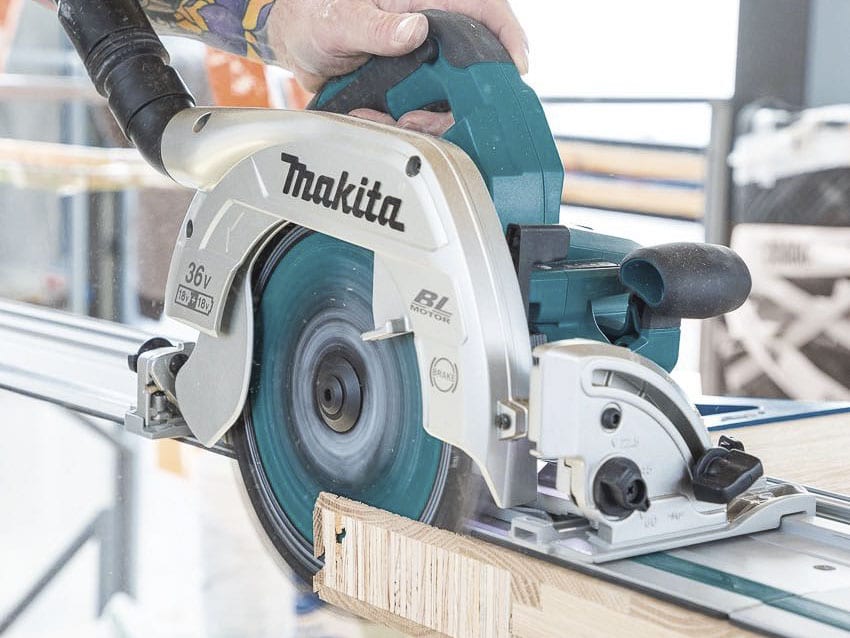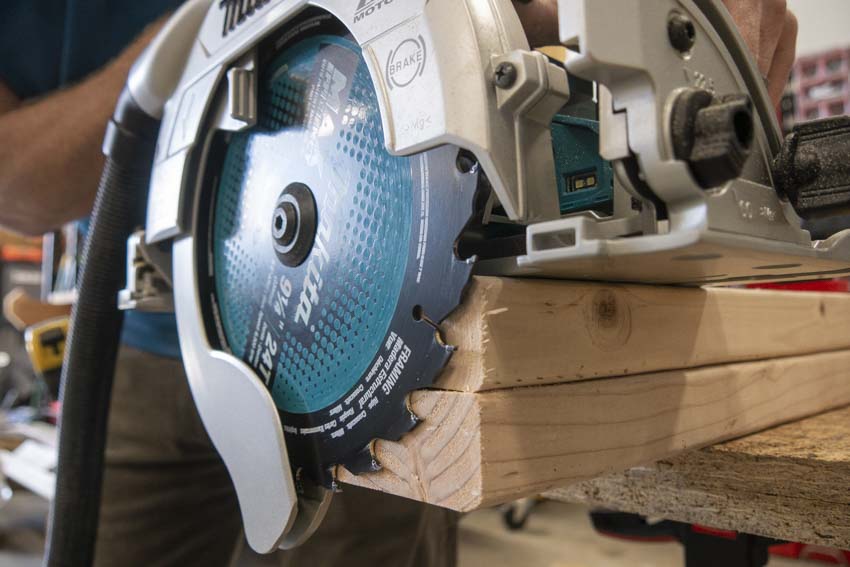Are you wondering if your circular saw blade is on backwards? Don’t worry, you’re not alone! It’s a common question that many DIY enthusiasts ask themselves. In this article, we’ll dive into this topic and provide you with some helpful insights and tips. By the end, you’ll be able to confidently determine whether your circular saw blade is facing the right way or if it needs a quick adjustment.
Now, let’s tackle this question head-on. So, how can you tell if your circular saw blade is on backwards? Well, there are a few telltale signs to look out for. We’ll walk you through those signs and explain why they indicate that your blade might be in the wrong position. By understanding these indicators, you’ll be equipped with the knowledge to assess the orientation of your circular saw blade.
But don’t worry, we’re not leaving you hanging when it comes to fixing this issue. We’ll also guide you through the process of reversing the blade if you determine it’s indeed on backwards. With our step-by-step instructions, you’ll be able to make the necessary adjustments quickly and easily. So, let’s get started and ensure your circular saw blade is ready to tackle any cutting task with precision and efficiency.
Discover the signs of a backwards circular saw blade and how to fix it. Incorrectly installing a saw blade can lead to poor cutting performance and safety hazards. Check for these indicators: 1) Teeth facing in the wrong direction; 2) Blade rotation causing kickback; 3) Uneven cuts or burning wood. To fix it, follow these steps: 1) Disconnect the saw from power; 2) Remove the blade; 3) Reinstall it with the teeth facing forward. Always ensure proper blade installation for efficient and safe cuts.

Is My Circular Saw Blade on Backwards? A Guide to Proper Blade Orientation
When it comes to using a circular saw, one common question that arises is whether the saw blade is installed correctly. The orientation of the blade can significantly impact the quality of your cuts and the overall performance of your saw. In this article, we’ll dive deep into the topic of circular saw blade orientation and discuss the signs to look for to determine if your blade is on backwards. We’ll also provide helpful tips to ensure you have the correct orientation for optimal results.
The Importance of Proper Blade Orientation
Before we delve into the signs of a backwards circular saw blade, let’s understand why proper blade orientation matters. When a circular saw blade is installed correctly, the cutting teeth should rotate in a counterclockwise direction. This orientation allows the blade to efficiently cut through materials, resulting in clean, precise cuts. If the blade is installed backwards, with the teeth rotating in the wrong direction, it can lead to various issues and compromise the quality of your work.
Signs that Your Circular Saw Blade is on Backwards
1. Poor Cutting Performance: One of the most obvious signs that your circular saw blade is on backwards is a significant decrease in cutting performance. If you notice that the blade is struggling to cut through materials, leaving rough and jagged edges, it’s likely that the blade is installed incorrectly. The backwards orientation impedes the blade’s ability to effectively engage with the material, resulting in inferior cuts.
2. Smoke and Burning: Another telltale sign of a backwards circular saw blade is the presence of smoke and burning during cutting. When the blade is on backwards, it creates excessive friction and heat, causing the material to burn or scorch. Additionally, the increased heat can damage the blade and compromise its longevity. If you notice smoke or burning while using your circular saw, it’s crucial to stop immediately and inspect the blade orientation.
3. Unwanted Tear-Out: When a circular saw blade is installed correctly, the teeth are designed to cut into the material smoothly, minimizing tear-out or splintering. However, with a backwards blade, the teeth are working against the grain, leading to increased tear-out and splintering. If you consistently experience rough or splintered edges when cutting, it’s a strong indicator that your blade is on backwards.
Tips for Proper Blade Orientation
1. Check the Manufacturer’s Instructions: The first step in ensuring proper blade orientation is referring to the manufacturer’s instructions for your specific circular saw model. The instructions will typically provide clear guidelines on how to install the blade correctly, including the proper orientation. Follow these instructions carefully to avoid any mistakes.
2. Look for Directional Indicators: Many circular saw blades have directional indicators that can help ensure the correct installation. These indicators may be in the form of arrows or labels indicating the proper rotation direction. Take a close look at the blade and its packaging to see if any directional indicators are present.
3. Tooth Orientation: Another way to determine blade orientation is by examining the position and orientation of the teeth. In most cases, the teeth should face towards the front of the saw, allowing them to engage with the material during the cutting process. If you’re unsure, consult the manufacturer’s instructions or consult with a professional.
Common Mistakes to Avoid when Installing a Circular Saw Blade
While we have covered the importance of proper blade orientation and provided tips for correct installation, it’s equally important to be aware of common mistakes to avoid. Here are three common errors to steer clear of:
Using the Wrong Blade Size
Using a circular saw blade that is the incorrect size for your saw can lead to various issues. It may not fit properly or engage with the arbor securely, compromising the safety and performance of your saw. Always check the blade size recommended by the manufacturer and ensure it matches your saw’s specifications.
Forgetting to Tighten the Blade
When installing a circular saw blade, it’s crucial to securely tighten it using the provided blade wrench or an appropriate tool. Failing to do so can result in the blade becoming loose during operation, posing a significant safety hazard. Take the time to properly tighten the blade to avoid accidents.
Not Cleaning the Arbor Shaft
Before installing a new blade, it’s essential to clean the arbor shaft, as debris or residue from previous blades can hinder proper installation. Use a brush or compressed air to remove any dirt or grime from the arbor shaft, ensuring a clean and secure connection between the blade and the saw.
Conclusion
Proper blade orientation is crucial for achieving accurate and clean cuts with your circular saw. By understanding the signs of a backwards blade and following the tips provided, you can ensure that your saw is performing optimally. Remember to consult the manufacturer’s instructions for your specific saw model and avoid common installation mistakes. By taking the time to install and orient your circular saw blade correctly, you’ll experience improved cutting performance and achieve the best results for your projects.
Key Takeaways: Is My Circular Saw Blade on Backwards?
- Make sure the teeth of the circular saw blade are facing the right direction.
- The teeth should be pointing towards the front of the saw.
- If the blade is on backwards, it may not cut properly and could cause kickback.
- Check the markings on the saw blade for indications of the correct installation.
- Always refer to the user manual for specific instructions on blade installation.
Frequently Asked Questions
Here are some common questions related to circular saw blades being placed backwards:
1. Why is my circular saw blade not cutting properly?
There can be various reasons why your saw blade is not cutting properly. One common issue could be that the blade is installed backwards. When the circular saw blade is placed on the saw, it should have the teeth facing forward, towards the front of the saw. If the blade is installed with the teeth facing the wrong way, it will not cut effectively and may cause splintering or ripping of the material being cut.
Alternatively, other factors like a dull blade, incorrect blade size for the material being cut, or improper saw setup could also result in subpar cutting performance. It’s essential to check all these potential factors to ensure your circular saw blade is cutting properly.
2. How do I determine if my circular saw blade is on backwards?
To determine if your circular saw blade is on backwards, first, make sure the saw is unplugged for safety. Then, visually inspect the blade. The teeth of the blade should be facing towards the front of the saw, which is the direction of the rotation. If the teeth are pointing towards the back, then the blade is installed backwards.
If you’re still unsure, you can also refer to the instruction manual of your circular saw. It will provide specific information on how to properly install the blade and ensure it is facing the correct direction.
3. What are the consequences of using a circular saw blade backwards?
Using a circular saw blade backwards can lead to several issues. Firstly, the blade will not cut efficiently and can cause the material being cut to splinter, tear, or burn. This can result in poor-quality cuts and damage to the workpiece.
Additionally, using a saw blade backwards can put excessive strain on the motor and other components of the saw, potentially causing premature wear and damage. This can lead to decreased performance and the need for costly repairs. It’s crucial to ensure the saw blade is correctly installed to avoid these consequences.
4. Can I flip the circular saw blade to fix the backward installation?
No, it is not recommended to flip a circular saw blade to fix a backward installation. Circular saw blades are designed asymmetrically, with specific tooth geometry that allows for efficient cutting in one direction. Flipping the blade can result in inaccurate cuts, increased vibration, and potential safety hazards.
If you realize you have installed the blade backwards, the best course of action is to remove and reinstall it correctly. Refer to the instruction manual for your specific saw model or seek guidance from a professional if needed.
5. How often should I check the installation of my circular saw blade?
It is a good practice to check the installation of your circular saw blade before each use. This includes verifying that the blade is properly seated and facing the correct direction. Regularly inspecting the installation ensures that your saw is set up for optimal and safe performance.
In addition to verifying the installation, it’s essential to inspect the blade for any damage or signs of wear. If the blade is bent, chipped, or excessively worn, it should be replaced to maintain cutting quality and prevent potential accidents.

He’s Doing it all WRONG! Cutting Metal with a Circular Saw and the Blade is Backwards! #tools #diy
Summary
So, if you’re wondering whether your circular saw blade is on backwards, here’s what you need to know. First, check for the direction arrows on the blade itself. Make sure the arrow matches with the direction of rotation of the saw. Remember, if the blade is on backwards, it won’t cut properly and can be dangerous. So be sure to double-check before starting your project.
Second, pay attention to the smooth and rough sides of the teeth. The smooth side should be facing forward when cutting through the material. This allows for a cleaner and more efficient cut. Finally, always follow the manufacturer’s instructions and wear appropriate safety gear when using power tools. Now you’re ready to confidently use your circular saw and get those projects done!
